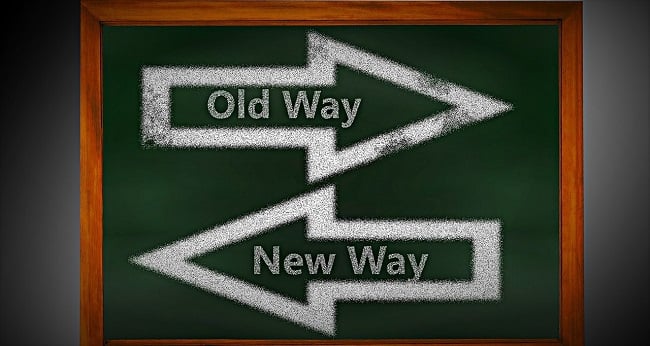The definition of insanity is repeating the same thing over-and-over and expecting different results.
It’s a powerful line. Catchy, cutting and also wrong. Yet there’s a lot to be learnt from it, especially when considering how your company’s behaviour reflects its vision.
First, let’s clear-up that line on insanity. Despite being forever linked to great thinkers such as Einstein and Mark Twain, it only first appeared in the 1984 mystery novel Sudden Death. For those interested, insanity is no longer recognised in the medical profession. It in fact only stands in legal circles, to explain not being able to distinguish fantasy from reality when discussing court proceedings.
Still, the basic idea is valid. Almost everybody will have worked in an environment where things must change but doing anything differently is met with resistance.
This is particularly prevalent when focusing on a brand’s marketing and communications. Often during a refresh, companies will set exciting new brand values, a progressive company vision and soaring goals. They may spend thousands on workshopping and creating these ideals, and even publicise them in beautifully written press releases.
Then comes the next day. In the office, very little has actually changed. There’s no road map or deliverables to bring about top-level decisions that reflect the business’ new vision or values. No matter how well-intentioned they were.
In this context, workplace behaviour must reflect a company's overall marketing strategy. It’s about taking a step back and auditing your day-to-day actions against your vision.
That may sound obvious, but failing to do so is a surprisingly common scenario. Fortunately, it is also one that can be avoided with the right approach.
Why we find it hard to change
Before making grand plans, we first must acknowledge why people find it hard to change.
To start with, admitting that behaviour needs to change means admitting that we’re currently doing something wrong. That is never an easy thing to do – whether because of pride or simply not understanding what we’re doing wrong.

Next, there’s the issue of finding the will. If change is required, there’s a good chance that a company isn’t running at optimum. At times like this motivation can be hard to come by. It’s much easier to clock in, do the usual and clock out. Even if we know that doing so has limited effectiveness.
Finally, there’s the no-small-matter of logistics. Just because change is required, it doesn’t just happen. There’s work to be done. Have employees enough time to work on changes? Is training available? What about the physical tools needed to do the job, for that matter?
Changing our behaviour is not as simple as agreeing on a direction and clicking our fingers. It takes daily effort, realistic targets and support. And while that can be difficult, it needn’t be impossible.
Getting your employees onboard
Paul Gordon, Director at strategic HR firm People Puzzles, wrote recently that the key to changing company behaviour is ensuring that all staff in your business are aligned with your top-level vision.
It’s crucial, here, to evaluate your message and check it’s understood. “Your message might make sense to you, but do your team members actually understand what you want?” asks Paul.
A recent study of 2,000 UK employees found that 52% of employees couldn’t recite their organisation’s vision, while 49% can’t recite their organisation’s values.
To drive greater engagement, those setting the company vision must better outline the real benefits that change will bring and how it can be achieved in the day-to-day.
Employees need to be invested in top-level strategy. Getting everyone on the same page is the best way to achieve this, including by offering opportunities for feedback and constructive criticism.
The alternative is behaviour changes that are forced top-down. Those which are only performed, not taken to heart. This latter approach may work for a time, but productive innovation can only occur when everybody believes in what they’re doing.
Jon Iwata, Head of Communications and Marketing at IBM, reflected on this in a 2009 Yale Club speech, saying: “The only way we can be comfortable in that world [where every employee has a voice] is if every employee of the company is truly grounded in what their company values and stands for.”
Measuring change
If change still isn’t taking hold, you have to ask if it is a ‘will’ or ‘skill’ issue, says Paul. “If it’s the latter then you have to give them the skills, because it might be that ‘I don’t know how’ was the issue all along. “If it’s a ‘will’ issue, then it’s behavioural and the choice is theirs… now it’s up to them… or face disciplinary.”
Change, of course, can be difficult to measure. This is why having a goal-orientated vision is so important. It gives staff a solid objective to work towards; one that can be understood and rewarded if achieved.
Many businesses now use strategy performance management tools to measure performance and outcomes against set goals. These ‘scorecards’ use an array of marks, surveys and checks to keep track of business objectives, including day-to-day tasks that will help manifest your vision.
How does your team behave?
Has your company set new strategic goals, or are you considering repositioning your values and long-term vision? Time to lay the groundwork for change, and ensure your whole team is committed to moving together.
The Marketing Centre’s 360 Health Check offers a free and confidential way to assess your strategic journey, with a four-step process to help you define, find, win and keep clients.




.png?width=800&height=500&name=12%20(1).png)
